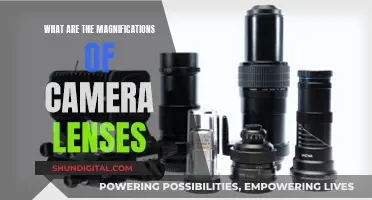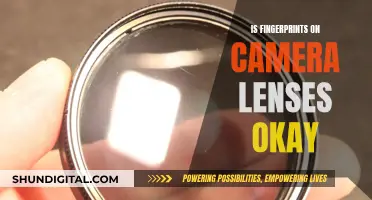
Camera lenses can degrade over time, but they don't have a set lifespan. With proper care, they can last for decades. However, there are several factors that can contribute to their deterioration, such as damage, fading coatings, dirt and dust, degraded cemented groups, and malfunctioning mechanical parts.
| Characteristics | Values |
|---|---|
| Lifespan | Decades |
| Factors affecting lifespan | Quality of parts, maintenance, usage, storage, cleaning techniques, accidents, manufacturing defects, improper use |
| Degradation signs | Focus ring jams, funny noises, dirt and dust, faded coatings, faulty motors, gears stripping, elements drifting out of alignment, fungus, lens separation |
What You'll Learn
- Lenses can degrade over time due to factors like dirt, dust, fungus, and loose parts
- Lenses can last for decades if properly maintained
- Lenses with more moving parts may have shorter lifespans
- Lenses with cheap parts and no weather sealing may not last as long
- Canon L lenses are known for their durability

Lenses can degrade over time due to factors like dirt, dust, fungus, and loose parts
Dirt, dust, and other environmental factors can cause camera lenses to degrade over time. While lenses are built to last, they are susceptible to wear and environmental factors.
Dirt and dust can enter the lens mechanism and cause issues with the mechanical parts, such as the focus and zoom mechanisms. This can result in blurry and distorted images. Fine particles like dust and sand can get inside the lens, especially during lens changes in dusty environments. These particles can scratch the lens elements and interfere with the lens's mechanical parts.
Additionally, the front element of a lens can pick up a film of pollutants from the atmosphere or storage environment over time. As the lens extends and retracts during focusing, it can act like a bellows, sucking in dust, water vapour, and fumes.
Proper lens maintenance and storage are crucial to minimising degradation. Regular cleaning and storing the lens in a dry, cool place can help prolong its lifespan. Using lens filters and protective cases can also provide extra protection from dirt and dust.
Camera Lenses: Are Their Filters Universal?
You may want to see also

Lenses can last for decades if properly maintained
One of the key factors affecting lens longevity is the build quality. Higher-quality lenses often feature better parts and weather sealing, which protects them from harmful environmental factors. Proper lens maintenance and treatment are also crucial in improving their lifespan.
While lenses can last for a long time, they are still susceptible to various issues. For example, coatings can fade, particularly on the front element, and smoke, dust, and other particulates can dirty internal lens surfaces. Additionally, cemented groups can degrade, AF motors can die, and elements can drift out of alignment.
To ensure the longevity of your lenses, it is important to handle them with care, protect them from extreme conditions, and store them properly when not in use. Regular cleaning and maintenance can also help extend their lifespan.
DX Lenses: Compatible with FX Cameras?
You may want to see also

Lenses with more moving parts may have shorter lifespans
Camera lenses can last for decades if they are well-maintained and not abused. However, lenses with more moving parts may have shorter lifespans than those with fewer moving parts. This is because more moving parts mean more opportunities for something to go wrong.
For example, the autofocus (AF) motor can die, or the zoom and manual focus (MF) gears can strip. In addition, lenses with more moving parts may be more likely to be dropped or knocked, which can cause internal components to become misaligned or damaged.
That being said, it's important to note that even lenses with many moving parts can last for a long time if they are well-maintained and not subjected to excessive wear and tear. Proper lens maintenance and treatment can help to improve its lifetime.
Some things to keep in mind to prolong the life of a lens with moving parts:
- Avoid dropping or knocking the lens.
- Store the lens in a safe place when not in use.
- Regularly clean the lens, being careful not to damage the coating.
- Consider using a filter to protect the front element.
- Send the lens for servicing if it starts to show signs of wear or malfunction.
Olympus Lenses: Universal Fit for All Olympus Cameras?
You may want to see also

Lenses with cheap parts and no weather sealing may not last as long
Cheaper lenses use lower-quality parts and are rarely weather-sealed. This means that they are more susceptible to damage from water and other environmental compounds.
In addition, cheaper lenses are more likely to have autofocus motors, zoom and manual focus gears, and other electronic components that can fail over time.
While lenses are generally durable, proper lens maintenance and treatment are important for improving their lifespan. This includes protecting them from extreme temperatures, physical shocks, and dirt and dust.
Camera Lenses: Waterproof or Not?
You may want to see also

Canon L lenses are known for their durability
Camera lenses can degrade over time, but Canon L lenses are known for their durability. Canon's L-series lenses are designed for professional use and to provide stable, trouble-free performance even in demanding working conditions. They are made with high-quality optical elements and designed to produce sharp photographic images. The manufacturing process and stringent controls ensure that the image quality of the L lenses is as good as it can be.
Most Canon L lenses are weather-sealed, meaning they are resistant to moisture, dust, and dirt. This makes them ideal for photographers who often shoot outdoors and are exposed to poor weather conditions. The lenses are made with high-grade metal, polycarbonate, and glass materials that can handle the wear and tear of frequent use.
Canon L lenses are also known for their sharpness. They are designed to produce the sharpest photographic images, incorporating specialized optical materials such as synthetic fluorite, Super UD, and UD glass, as well as large-aperture high-precision aspherical lenses. Only lenses that perform to the highest photographic standards are designated as L lenses by Canon.
In addition to their durability and sharpness, Canon L lenses offer a wide range of other features. They tend to be "fast," with maximum apertures of f/2.8 or f/4, and they often have ultrasonic autofocus motors (USM) for quick and accurate focusing. Larger L lenses, such as the 70-200mm and 100-400mm zooms, usually have an off-white barrel to reduce heat absorption under the sun, ensuring consistent performance even in hot weather.
While Canon L lenses are known for their durability, it is important to note that they do have breakable elements and moving parts that can wear out over time. Proper care and maintenance can help extend the life of these lenses. Overall, Canon L lenses are a great choice for photographers looking for durability, sharpness, and a range of professional-grade features.
Camera Lenses: Radioactive or Not?
You may want to see also
Frequently asked questions
No, camera lenses do not have an expiry date. However, they do have a lifespan and can degrade over time. The glass elements will remain the same, but coatings can fade, and internal mechanisms can wear.
Several factors can cause camera lenses to degrade, including dirt, dust, and other pollutants in the air, physical damage, manufacturing defects, and age.
To extend the lifespan of your camera lens, it is important to handle it with care and store it properly. Regular cleaning and maintenance can also help to prolong its life.







